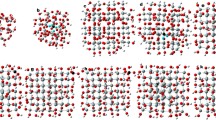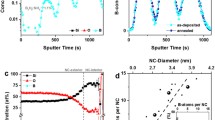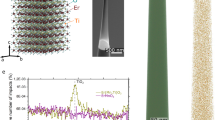Abstract
We analyze phosphorus (P)- and boron (B)-doped silicon nanocrystals (Si NCs) with various compositions of silicon-rich oxide using atom probe tomography. By creating Si iso-concentration surfaces, it is confirmed that there are two types of Si NC networks depending on the amount of excess Si. A proximity histogram shows that P prefers to locate inside the Si NCs, whereas B is more likely to reside outside the Si NCs. We discuss the difference in a preferential location between P and B by a segregation coefficient.






Similar content being viewed by others
Change history
01 December 2016
An Erratum to this paper has been published: https://doi.org/10.1557/mrc.2016.47
References
G. Conibeer, M. Green, E.-C. Cho, D. König, Y.-H. Cho, T. Fangsuwannarak, G. Scardera, E. Pink, Y. Huang, T. Puzzer, S. Huang, D. Song, C. Flynn, S. Park, X. Hao, and D. Mansfield: Silicon quantum dot nanostructures for tandem photovoltaic cells. Thin Solid Films 516, 6748 (2008).
H. Sugimoto, M. Fujii, K. Imakita, S. Hayashi, and K. Akamatsu: Phosphorus and boron codoped colloidal silicon nanocrystals with inorganic atomic ligands. J. Phys. Chem. C 117, 6807 (2013).
C.-W. Jiang and M.A. Green: Silicon quantum dot superlattices: modeling of energy bands, densities of states, and mobilities for silicon tandem solar cell applications. J. Appl. Phys. 99, 114902 (2006).
G.M. Dalpian and J.R. Chelikowsky: Self-purification in semiconductor Nanocrystals. Phys. Rev. Lett. 96, 226802 (2006).
M. Fujii, A. Mimura, S. Hayashi, and K. Yamamoto: Photoluminescence from Si nanocrystals dispersed in phosphosilicate glass thin films: improvement of photoluminescence efficiency. Appl. Phys. Lett. 75, 185 (1999).
M. Zacharias, J. Heitmann, R. Scholz, U. Kahler, M. Schmidt, and J. Biasing: Size-controlled highly luminescent silicon nanocrystals: a SiO/SiO2 superlattice approach. Appl. Phys. Lett. 80, 661 (2002).
G. Conibeer, M.A. Green, D. König, I. Perez-Wurfl, S. Huang, X. Hao, D. Di, L. Shi, S. Shrestha, B. Puthen-Veetil, Y. So, B. Zhang, and Z. Wan: Silicon quantum dot based solar cells: addressing the issues of doping, voltage and current transport. Prog. Photovolt: Res. Appl. 19, 813 (2011).
B. Gault, M.P. Moody, J.M. Cairney, and S.P. Ringer: Atom Probe Microscopy (Springer, New York, 2012).
M. Fujii, S. Hayashi, and K. Yamamoto: Photoluminescence from B-doped Si nanocrystals. J. Appl. Phys. 83, 7953 (1998).
S. Hernández, J. López-Vidrier, L. López-Conesa, D. Hiller, S. Gutsch, J. Ibáñez, S. Estradé, F. Peiró, M. Zacharias, and B. Garrido: Determining the crystalline degree of silicon nanoclusters/Si02 multi-layers by Raman scattering. J. Appl. Phys. 115, 203504 (2014).
T.C.-J. Yang, K. Nomoto, Z. Lin, L. Wu, B. Puthen-Veettil, T. Zhang, X. Jia, G. Conibeer, and I. Perez-Wurfl: High Si Content SRO/SiO2 Bilayer Superlattices with Boron and Phosphorus Doping for Next Generation Si Quantum Dot Photovoltaics. in Proceedings of the 42nd IEEE Photovoltaic Specialists Conference doi: 10.1109/PVSC.2015.7355967 (2015).
P.J. Felfer, T. Alam, S.P. Ringer, and J.M. Cairney: A reproducible method for damage-free site-specific preparation of atom probe tips from interfaces. Mirosc. Res. Techn. 75, 484 (2012).
F. Vurpillot, B. Gault, B.P. Geiser, and D.J. Larson: Reconstructing atom probe data: a review. Ultramicroscopy 132, 19 (2013).
O.C. Hellman, J.A. Vandenbroucke, J. Rusing, D. Isheim, and D. N. Seidman: Analysis of three-dimensional atom-probe data by the Proximity Histogram. Microsc. Microanal. 6, 437 (2000).
A.M. Hartel, D. Hiller, S. Gutsch, P. Löper, S. Estradé, F. Peiró, B. Garrido, and M. Zacharias. Formation of size-controlled silicon nanocrystals in plasma enhanced chemical vapor deposition grown SiOxNy/SiO2 super-lattices. Thin Solid Films 520, 121 (2011).
V. Mulloni, P. Bellutti, and L. Vanzetti: XPS and SIMS investigation on the role of nitrogen in Si nanocrystals formation. Surf. Sci. 585, 137 (2005).
A. Sarikov, V. Litovchenko, I. Lisovskyy, I. Maidanchuk, and S. Zlobin: Role of oxygen migration in the kinetics of the phase separation of non-stoichiometric silicon oxide films during high-temperature annealing. Appl. Phys. Lett. 91, 133109 (2007).
D. Hiller, S. Gutsch, A.M. Hartel, P. Lbper, T. Gebel, and M. Zacharias: A low thermal impact annealing process for Si02-embedded Si nanocrystals with optimized interface quality. J. Appl. Phys. 115, 134311 (2014).
J. Laube, S. Gutsch, D. Wang, M. Zacharias, and D. Hiller: Two-dimensional percolation threshold in confined Si nanoparticle networks. Appl. Phys. Lett. 108, 043106 (2016).
F.A. Trumbore: Solid solubilities of impurity elements in Germanium and silicon. Bell Syst. Tech. J. 39, 205 (1960).
R.W. Olesinski, N. Kanani, and G.J. Abbaschian: The P-Si (Phosphorus-Silicon) system. Bull. Alloy Phase Diagr. 6, 130 (1985).
R.W. Olesinski and G.J. Abbaschian: The B-Si (Boron-Silicon) system. Bull. Alloy Phase Diagr. 5, 478 (1984).
K. Sumida, K. Ninomiya, M. Fujii, K. Fujio, S. Hayashi, M. Kodama, and H. Ohta: Electron spin-resonance studies of conduction electrons in phosphorus-doped silicon nanocrystals. J. Appl. Phys. 101, 033504 (2007).
M. Ghezzo and D.M. Brown: Diffusivity summary of B, Ga, P, As, and Sb in SiO2. J. Electrochem. Soc. 120, 146 (1973).
R.B. Fair and J.C.C. Tsai: A quantitative model for the diffusion of phosphorus in silicon and the emitter dip effect. J. Electrochem. Soc. 124, 1107 (1977).
R.B. Fair: Boron diffusion in silicon-concentration and orientation dependence, background effects, and profile estimation. J. Electrochem. Soc. 122, 800 (1975).
G. Hadjisavvas and P.C. Kelires: Structure and energetics of Si Nanocrystals embedded in a-SiO2. Phys. Rev. Lett. 93, 226104 (2004).
K. Sakamoto, K. Nishi, F. Ichikawa, and S. Ushio: Segregation and transport coefficients of impurities at the Si/SiO2 interface. J. Appl. Phys. 61, 1553 (1987).
N. Fukata, S. Ishida, S. Yokono, R. Takiguchi, J. Chen, T. Sekiguchi, and K. Murakami: Segregation behaviors and radial distribution of Dopant atoms in silicon nanowires. Nano Lett. 11, 651 (2011).
A.S. Grove, O. Leistiko, and C.T.J. Sah: Redistribution of acceptor and donor impurities during thermal oxidation of silicon. J. Appl. Phys. 35, 2695 (1964).
Acknowledgments
This research has been supported by the Australian Government through the Australian Renewable Energy Agency (ARENA). Responsibility for the views, information, or advice expressed herein is not accepted by the Australian Government. The authors acknowledge the facilities and the scientific and technical assistance of the Australian Microscopy & Microanalysis Research Facility (AMMRF) at the Australian Centre for Microscopy & Microanalysis at the University of Sydney. This research was supported by the Faculty of Engineering & Information Technologies, The University of Sydney, under the Faculty Research Cluster Program. This work is partly supported by 2015 JST Visegrad Group (V4)-Japan Joint Research Project on Advanced Materials, and KAKENHI (16H03828). The authors thank T. Kanno (Kobe University) and Dr. T. C.-J. Yang (UNSW) for sample preparation, and the group of Prof. Zacharias (IMTEK) for providing part of the samples used in this study.
Author information
Authors and Affiliations
Corresponding authors
Rights and permissions
About this article
Cite this article
Nomoto, K., Gutsch, S., Ceguerra, A.V. et al. Atom probe tomography of phosphorus- and boron-doped silicon nanocrystals with various compositions of silicon rich oxide. MRS Communications 6, 283–288 (2016). https://doi.org/10.1557/mrc.2016.37
Received:
Accepted:
Published:
Issue Date:
DOI: https://doi.org/10.1557/mrc.2016.37




